Posted 03.20.2024 by Josh Krakauer
6 Rebranding Announcement Examples for Social Media: A Study
Rebranding is never easy. In this article, we dissect six examples to show you the do's, dont's, and tips to do it right.
Announcing a rebrand is never easy.
First of all, a rebranding announcement marks the culmination of a stressful process (rebranding) by revealing a completely new narrative to the audience.
In other words, an actual pivotal moment!
Second, rebranding announcements are meant to draw attention – lots of it.
While most marketers wish for swaths of positive attention here, experienced ones know what to expect: Tons of scrutiny, a variety of criticism, and apathy.
Third, rebranding announcements demands a deep understanding of social media platforms, as these are the primary channels for delivering the message.
Altogether, it’s a challenge with huge implications for brands, and getting it right is crucial.
So, how to get it right when announcing the change on social?
Rather than sharing a method, we’ve decided to curate a list of real-life rebranding announcement examples this time.
Let’s see how they did it, and share some notes along the way.
1. Twitter rebrands to X
Twitter’s rebranding to X took place in 2023, and was commanded by – who else if not – its new overlord owner, Elon Musk.
The rebranding reflected the company’s departure from microblogging and the broadening of its scope.
The rebranding announcement itself was unorthodox.


It came out over three tweets that Musk shared on July 23, 2023.
He started by teasing the audience, created momentum shortly after, and finished the job with a confirmation of the new brand.
The posts ended up garnering 180+ million views, over half a million reactions, and hundreds of thousands of comments and reshares.
What we like about this rebranding announcement:
- Starting from the top. It plays to one of Musk’s strengths (its visibility as a public persona) to deliver the message. If you have a public CEO, consider breaking the news from their account first.
- Timing. Musk had just acquired Twitter, and half the world was watching. Lots of eyeballs can be attributed to the timing alone.
- Messaging. Musk has been quite ambiguous about many things during his career but managed to be concise here.
What we don’t like:
- Confusion for users. It used a phrase (“We shall bid adieu to the Twitter brand and, gradually, to all the birds”) that is sort of mysterious. What did he mean by bidding goodbye to all the birds?
- It still conjured quite a bit of negative attention, as these were already turbulent times for both Musk and Twitter.
It’s still too early to tell if the rebranding will succeed but the unconventional social media announcement surely created waves.
2. Facebook rebrands to Meta
Another bold move by a giant tech player, although this one made more sense at the time it took place…kind of.
Let’s take a short trip down memory lane.
It was the autumn of 2021. The world was still very much troubled by the Covid pandemic, and tech companies – including Instagram, Facebook, and WhatsApp – were seeing usage and revenue numbers skyrocket.
At the same time, Zuckerberg was going all-in with the Metaverse, remember that?
In this context, moving into a new brand that reflects diversification and innovation does not sound surprising (but it sure was back then!).
As for the announcement itself, here’s how they broke the news:
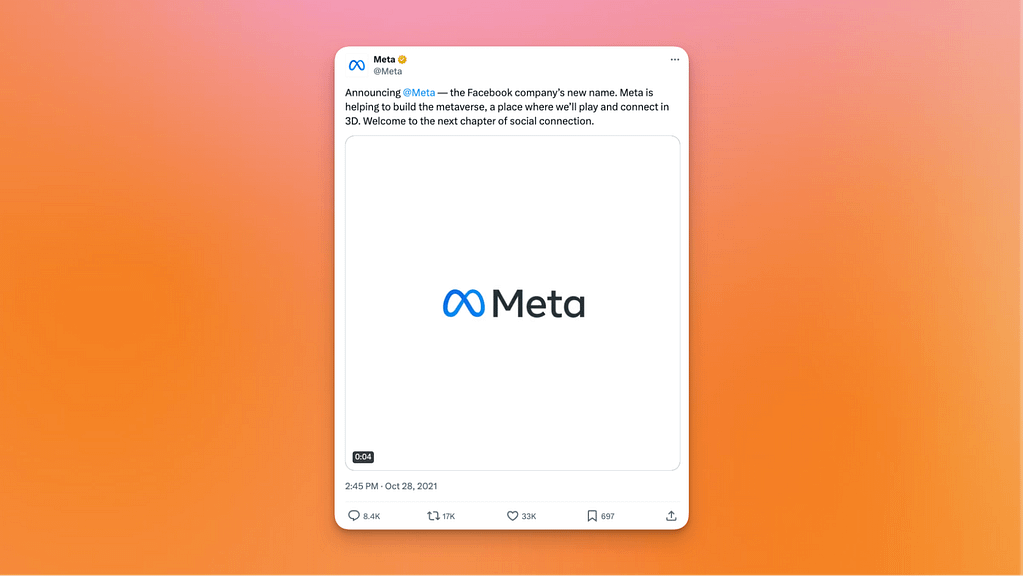
The announcement was clear, direct, and accompanied by a short video for extra context and impact.
Moreover, they did a few other things we’d want to draw attention to beyond this initial post:
- They made a bigger narrative video that condenses the reasons behind the rebranding.
- They tagged brands to get conversations started.
- They made a video with Zuck explaining why – talk about leadership taking ownership!
- They ran with memes.
- They incorporated influencers to feel more relevant.
While not as far-reaching as Twitter, Meta still gathered quite several reactions from the announcement, making the front page of the internet for a few days.
What we like about this announcement:
- Messaging. Short, professional, optimistic.
- Visuals. A brief introduction to the new brand identity to familiarize users, with visuals acting as a side dish for the main message.
- Variety. Beyond the initial post, Meta stayed active on launch day, following up with many posts covering different angles and building on the excitement.
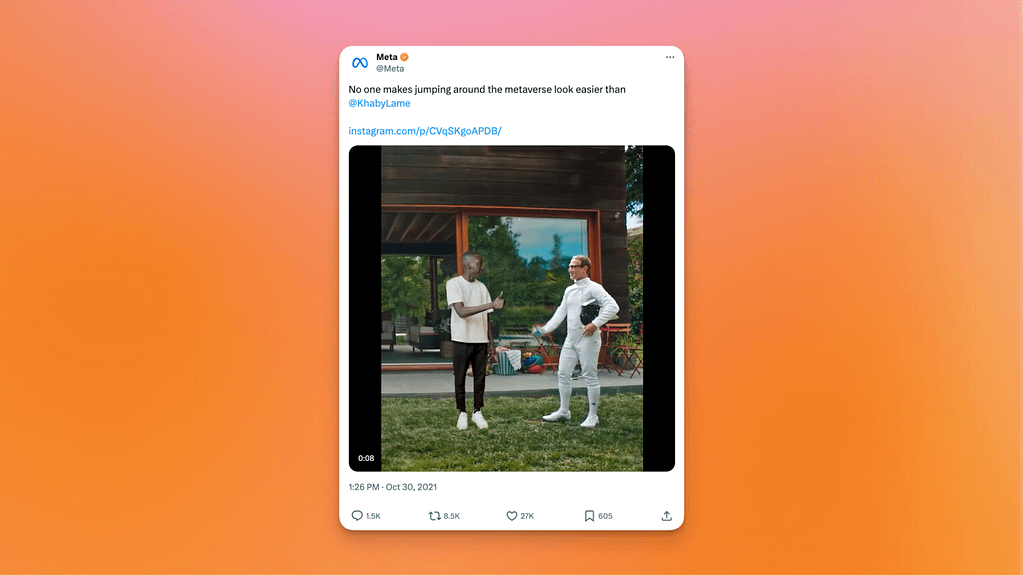
3. Lambda School rebrands to Bloom Institute of Technology
Lambda School started as a coding bootcamp that offered students the possibility to defer tuition until they landed a job paying 50k or above per year.
Students would sign an income-sharing agreement with the company, get their education, and pay it back once the good jobs came.
However, the company found itself in a series of controversies soon after being launched in 2017, becoming the focus of some negative attention from specialized press by 2020.
As rumors and chit-chat spread, the company announced a full rebrand, and in November 2021, Lambda School turned into Bloom Institute of Technology, aka Bloomtech.

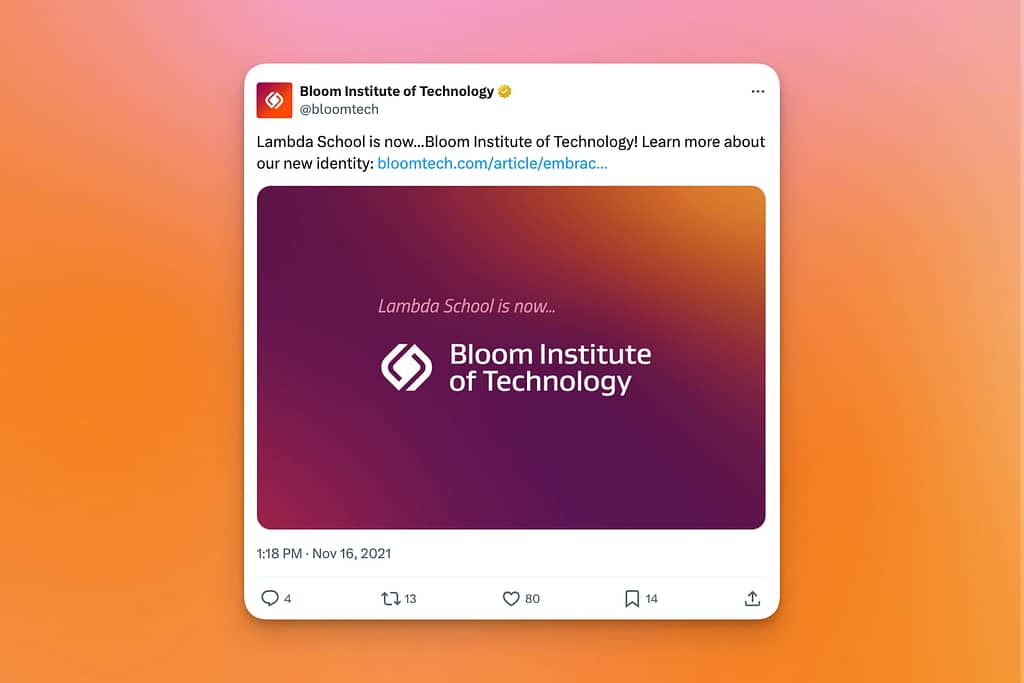
The announcement itself was a mixed one, relying on the new brand’s social accounts, and the CEO’s exposure.
It used the first to deliver a short, on-point message, and the second to get increased exposure.
What we like about this announcement:
- Leverages the CEO’s established audience for increased reach and exposure. A good example of a well-crafted executive social media strategy.
- Introduces the new brand in full and shares everything in one package (name, visual identity, PR release, company mission).
- Follow-up information. The rebranding produced dozens of comments, and the company seemed to have all the right answers lined up already.
All things considered, there’s nothing we don’t like about the announcement. A professional work carried out flawlessly.
4. HBO Max rebrands to Max
So far, we’ve analyzed three examples of good rebranding announcements for social media.
Now, it’s time to change the mood a little bit and explore not-so-good ones.
The HBO Max rebranding into Max fits the bill here.
First of all, it was not a full rebranding from the get-go. The rebrand was launched in the US, but it was slowly rolled out across the world later on.
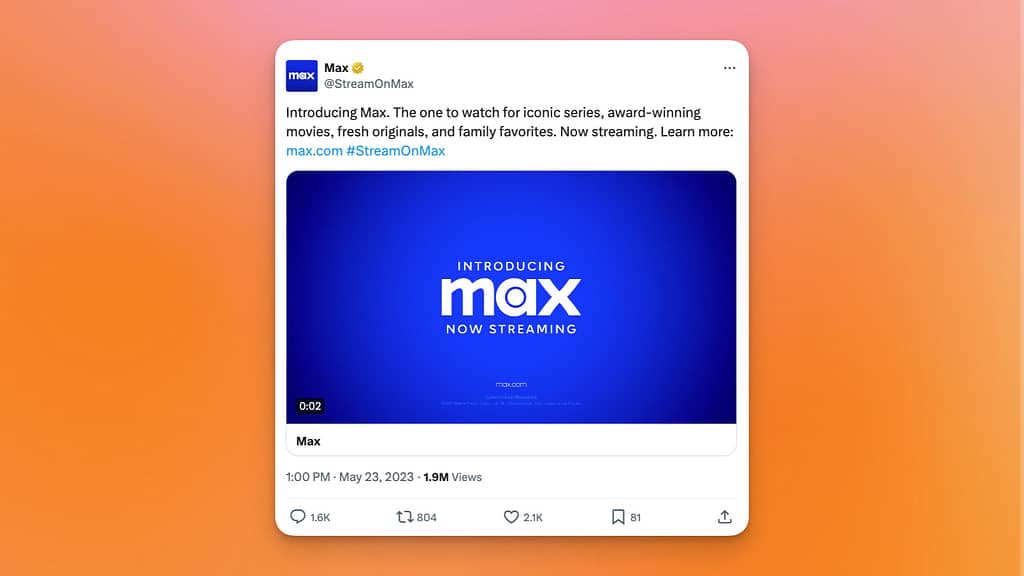
To add more confusion, they kept the original domain for many territories but added the new brand identity to some parts of the website (but not all).
Finally, the announcement didn’t take advantage of the company’s most important assets – its prestigious, memorable collection of films and series.
Despite all the misses, the announcement still managed to gather attention, collecting almost 2 million views and 1,600 comments on X.
What we like about this announcement:
- The new brand identity is front and center, allowing users to quickly identify the changes.
- The announcement introduced the new web domain, allowing users to check it out by themselves.
What we don’t like:
- The brand didn’t leverage existing, evergreen assets to relate with the audience.
- The video is pretty bland – helps identify the new identity, but not much else goes on.
- The comment section turned into the social media equivalent of a nuclear wasteland. Lots of negative commentary, with conversations drifting away from the announcement right off the bat.
- It missed the opportunity to reply to resounding jokes on the rebrand. Always remember, the comment is the content!
5. Google Bard rebrands to Gemini
On February 8, 2024, Google announced the rebranding of its large language model (LLM) Bard to Gemini.
They did it flawlessly, that is, by posting an informative, visually on-point short thread on X.
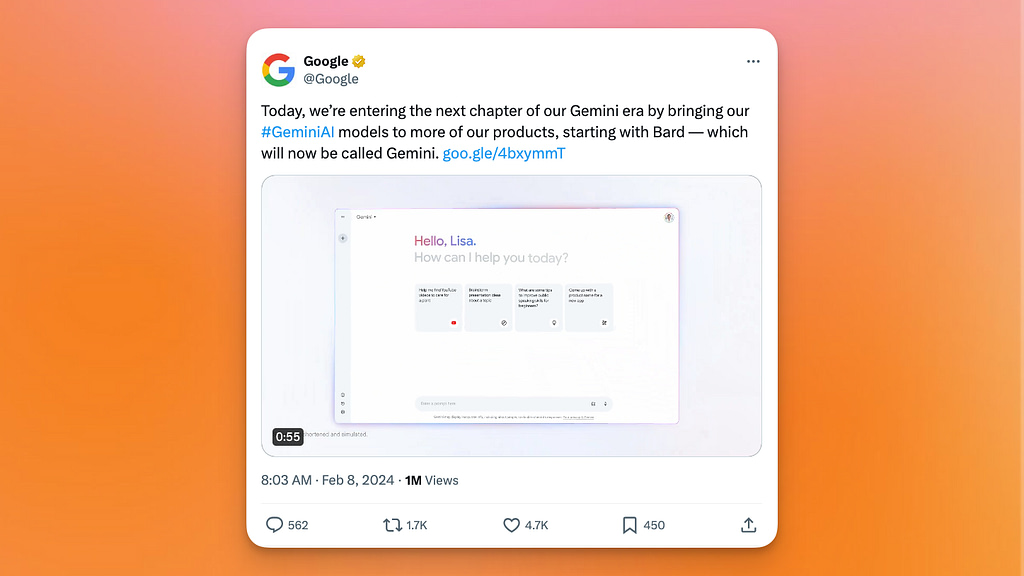
The announcement featured every item you’d expect from a professional, including:
- The strategic reason behind the rebranding.
- A unique hashtag to further amplify the reach of the post.
- A link to a web page with more details on the rebranding.
- Bits on the latest product iterations.
- Timely, casual answers to the comments (which include contributions from influencers, thought leaders, and notable companies like OnePlus).
The results were in line with the work done above: Over 5 thousand reactions and a few hundred comments.
In other words, a great (new) start for a product that saw itself under the large shadow of ChatGPT just a year before.
6. MessageBird rebrands to Bird
To close this series of rebranding announcements, we’re taking another turn and showing you how a niche tech SaaS company did it.
MessageBird, a CRM for marketing and sales powering personalized interactions on email, SMS, and texting platforms, announced its rebrand to Bird in February 2024.
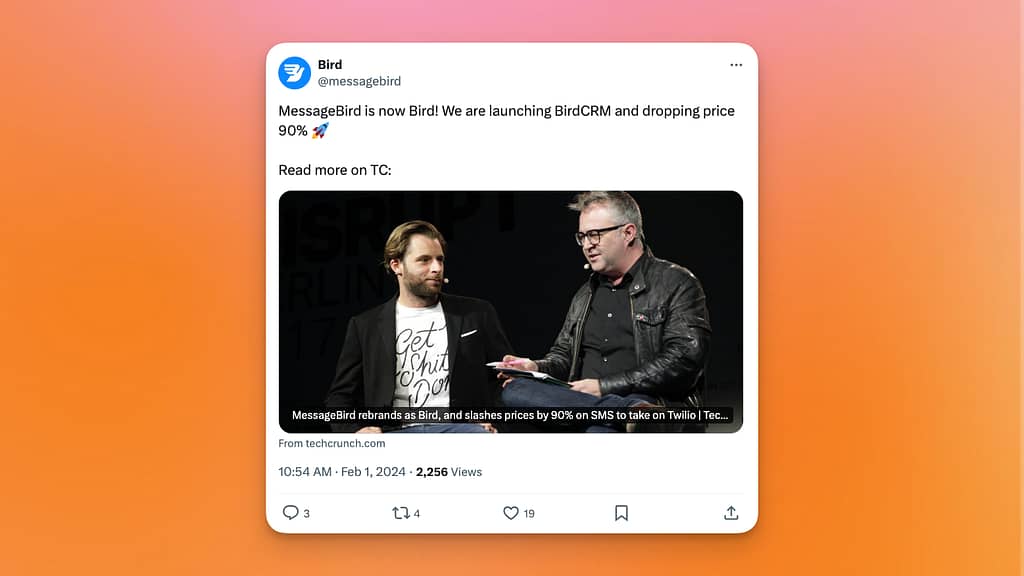
Although the announcement didn’t make waves, there are a couple of lessons to learn here.
First, they announce the rebranding, and at the same time, they share an immediate benefit for users – a 90% slash in pricing.
Employees backed up the announcement with LinkedIn posts to spread the news.
To conclude, they linked to a story from a reputable source covering the rebrand.
Not spectacular, but played by the book.
What we don’t like:
- There were multiple support questions in the rebrand announcement X post where customers went unanswered. At a time when you want to signal trust, this is a big miss.
The takeaway: Simple rules to announce a rebrand on social media
Rebranding announcements for social media require timely, attention-grabbing content to drive positive engagement and set the foundational stone for the brand’s new identity.
On top of this, brands announcing a rebranding should always take into account the following:
- Context: Is the company well-known, and on good terms with the general audience and stakeholders? Will the public be delighted or disinterested?
- Audience: Does the company have a significant audience to engage with?
- Previous engagements: How does the audience engage with the company on social media? Are the exchanges usually positive, or is it just a collection of claims and customer support questions?
Once the picture is clear, the rebranding announcement must check the following boxes:
- Narrative and messaging: Develop a concise and engaging story that communicates the reasons behind the rebrand, emphasizing the benefits and vision for the future.
- Brand identity: Share the new brand identity through visually striking graphics, videos, or animations that showcase the new branding elements, such as logos, colors, and imagery.
- People and platforms: Use multiple social media platforms and accounts (employees, executives, brand channels)to reach a wider audience and tailor the messaging to suit each.
- Post-announcement engagement: Be there to answer to comments and questions from followers, and be prepared to respond promptly to inquiries or concerns.
- Timing: Choose the timing of the announcement carefully to maximize visibility and engagement, considering factors such as peak hours, relevant events, or industry trends.
- Amplification: Make the most of your existing partnerships. Collaborate with employee brand advocates, executives, and influencers to amplify the rebranding message. Consider paid amplification (boosting) of those posts on top to ensure wide coverage if the response is positive.
Armed with the theory and practice, you now know how rebranding announcements for social media works. And if in doubt, you can always reach out to us for help!
